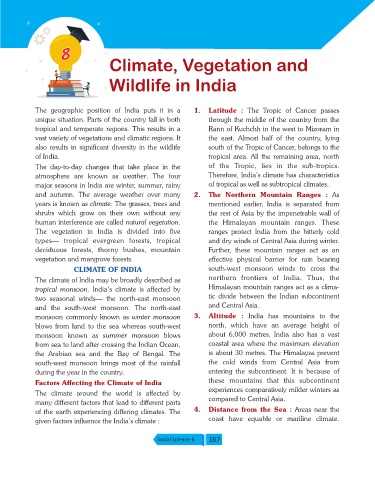Page 167 - SST Class 06
P. 167
8 8 8
Climate, Vegetation and
Wildlife in India
The geographic position of India puts it in a 1. Latitude : The Tropic of Cancer passes
unique situation. Parts of the country fall in both through the middle of the country from the
tropical and temperate regions. This results in a Rann of Kuchchh in the west to Mizoram in
vast variety of vegetations and climatic regions. It the east. Almost half of the country, lying
also results in significant diversity in the wildlife south of the Tropic of Cancer, belongs to the
of India. tropical area. All the remaining area, north
The day-to-day changes that take place in the of the Tropic, lies in the sub-tropics.
atmosphere are known as weather. The four Therefore, India’s climate has characteristics
major seasons in India are winter, summer, rainy of tropical as well as subtropical climates.
and autumn. The average weather over many 2. The Northern Mountain Ranges : As
years is known as climate. The grasses, trees and mentioned earlier, India is separated from
shrubs which grow on their own without any the rest of Asia by the impenetrable wall of
human interference are called natural vegetation. the Himalayan mountain ranges. These
The vegetation in India is divided into five ranges protect India from the bitterly cold
types— tropical evergreen forests, tropical and dry winds of Central Asia during winter.
deciduous forests, thorny bushes, mountain Further, these mountain ranges act as an
vegetation and mangrove forests. effective physical barrier for rain bearing
CLIMATE OF INDIA south-west monsoon winds to cross the
The climate of India may be broadly described as northern frontiers of India. Thus, the
tropical monsoon. India’s climate is affected by Himalayan mountain ranges act as a clima-
two seasonal winds— the north-east monsoon tic divide between the Indian subcontinent
and the south-west monsoon. The north-east and Central Asia.
monsoon commonly known as winter monsoon 3. Altitude : India has mountains to the
blows from land to the sea whereas south-west north, which have an average height of
monsoon known as summer monsoon blows about 6,000 metres. India also has a vast
from sea to land after crossing the Indian Ocean, coastal area where the maximum elevation
the Arabian sea and the Bay of Bengal. The is about 30 metres. The Himalayas prevent
south-west monsoon brings most of the rainfall the cold winds from Central Asia from
during the year in the country. entering the subcontinent. It is because of
Factors Affecting the Climate of India these mountains that this subcontinent
experiences comparatively milder winters as
The climate around the world is affected by
compared to Central Asia.
many different factors that lead to different parts
of the earth experiencing differing climates. The 4. Distance from the Sea : Areas near the
given factors influence the India’s climate : coast have equable or mariline climate.
Social Science-6 167

